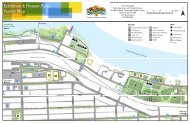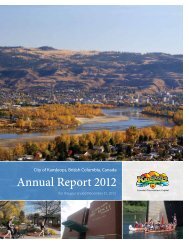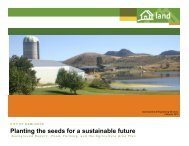GEOTOUR GUIDE - City of Kamloops
GEOTOUR GUIDE - City of Kamloops
GEOTOUR GUIDE - City of Kamloops
Create successful ePaper yourself
Turn your PDF publications into a flip-book with our unique Google optimized e-Paper software.
(sTop 12) peTro-Canada peTroleum sToraGe depoT:<br />
Gasoline and diesel fuels. Where do They Come from?<br />
Figure 49. Bulk petroleum storage depot on Tranquille Road near the<br />
airport. Tanker trucks transport gasoline from the depot to gas stations from<br />
Merritt to Williams Lake in the BC Interior. The depot is adjacent to the<br />
Trans Mountain Pipeline. (Photo by R.Turner)<br />
Figure 50. The smoothed and revegetated scar marks the buried route <strong>of</strong> the<br />
Trans Mountain Pipeline up the valley slope north <strong>of</strong> the petroleum depot<br />
and airport. The pipeline transports gasoline and diesel, each in separate<br />
batches, over 1000 kilometres from refineries in Edmonton via <strong>Kamloops</strong> to<br />
Vancouver and Washington State. The 60 cm diameter pipeline is owned<br />
by Kinder Morgan Ltd. and can transport over to 250,000 barrels <strong>of</strong> oil per<br />
day. (Photo by R.Turner)<br />
WhaT aBouT ClimaTe ChanGe?<br />
Gasoline, diesel, and natural gas provide vital energy for<br />
vehicles, industry, and homes in <strong>Kamloops</strong>. These fuels reach<br />
<strong>Kamloops</strong> by pipeline from oil refineries in Alberta and gas<br />
plants in northeastern BC, and are part <strong>of</strong> a broader range<br />
<strong>of</strong> petroleum-based products such as asphalt and plastics.<br />
Gasoline and diesel are carried by pipeline from Edmonton<br />
to <strong>Kamloops</strong> and are stored at a petroleum depot near the<br />
airport. Various fuel retailers such as Shell, Husky, and Esso<br />
mix additives to the gasoline or diesel fuel and then transport<br />
thefuel by truck to gas stations throughout the Interior. The<br />
route <strong>of</strong> the natural gas pipeline that connects northeastern<br />
BC gas fields to markets in Vancouver passes to the west <strong>of</strong><br />
<strong>Kamloops</strong> at Savona. A branch pipeline brings natural gas<br />
from Savona to <strong>Kamloops</strong>.<br />
Oil and natural gas come from the Earth. Most natural<br />
gas used in British Columbia comes from deep reservoirs<br />
beneath northeastern BC. Most oil used in BC comes from<br />
rock reservoirs deep buried below Alberta or from the giant<br />
deposits <strong>of</strong> tar sands in northeastern Alberta. Oil and natural<br />
gas and coal are referred to as “fossil fuels” because they are<br />
derived from ancient (or “fossil”) animals and plants that were<br />
buried in the sediments <strong>of</strong> ancient seafloors and swamps. Deep<br />
burial at high temperatures and pressures caused organic<br />
matter to release hydrocarbon liquids and gases that flowed<br />
through the underground and some <strong>of</strong> which became trapped<br />
in rock reservoirs. Oil and natural gas are extracted from<br />
these reservoirs by drilling wells, <strong>of</strong>ten to depths <strong>of</strong> 1000 to<br />
3000 metres below the surface. Oil and natural gas occur in the<br />
spaces, millimetres to centimetres in size, within sandstone or<br />
limestone layers.<br />
In spite <strong>of</strong> the tremendous benefits and convenience <strong>of</strong> fossil fuels, a clear consensus has developed among climate and atmospheric<br />
scientists that the greenhouse gases produced from the use <strong>of</strong> oil and natural gas and coal are dramatically changing the<br />
composition <strong>of</strong> our atmosphere and contributing to global climate change.<br />
British Columbia has warmed significantly in the last 100 years and direct evidence <strong>of</strong> this is seen in the widespread and rapid<br />
recession <strong>of</strong> glaciers in the Columbia and Rocky Mountains to the east and Coast Mountains to the west. One <strong>of</strong> the most<br />
dramatic impacts <strong>of</strong> climate change in BC is the spread <strong>of</strong> the mountain pine beetle infestation. Forests throughout central BC<br />
are infected, and the infestation is spreading east into Alberta. Formerly, periods <strong>of</strong> very cold winter weather held the beetles<br />
in check. However, warming winter temperatures have allowed the beetle to thrive. The rapid death <strong>of</strong> our extensive interior<br />
forests is a huge challenge for the forestry industry and the communities that depend on that industry. The financial costs will<br />
be very high, likely billions <strong>of</strong> dollars.<br />
28

















